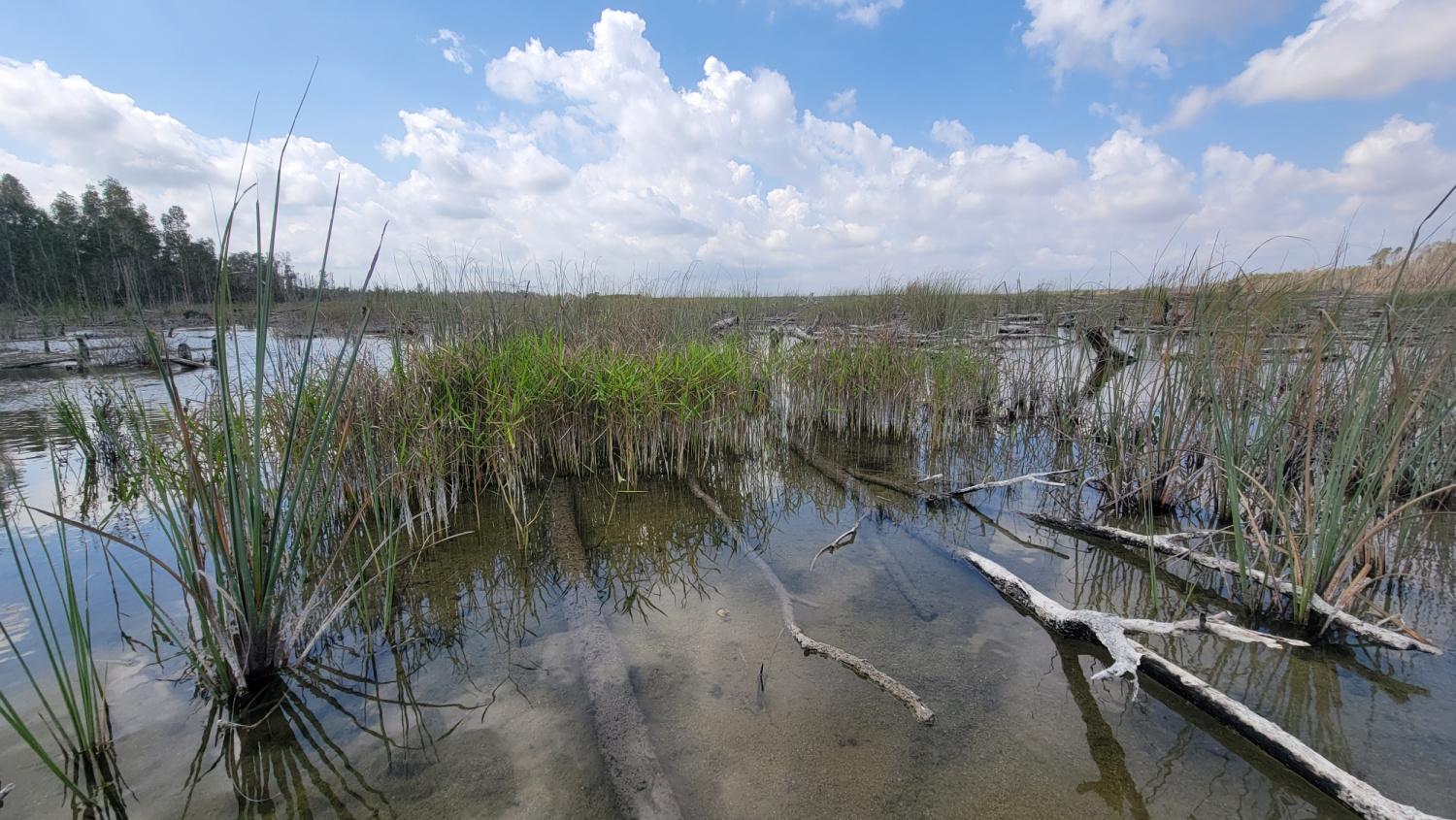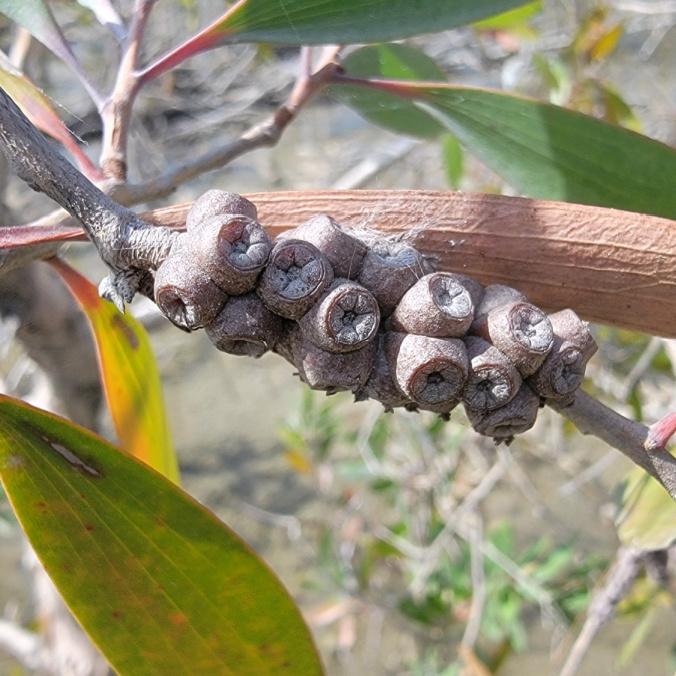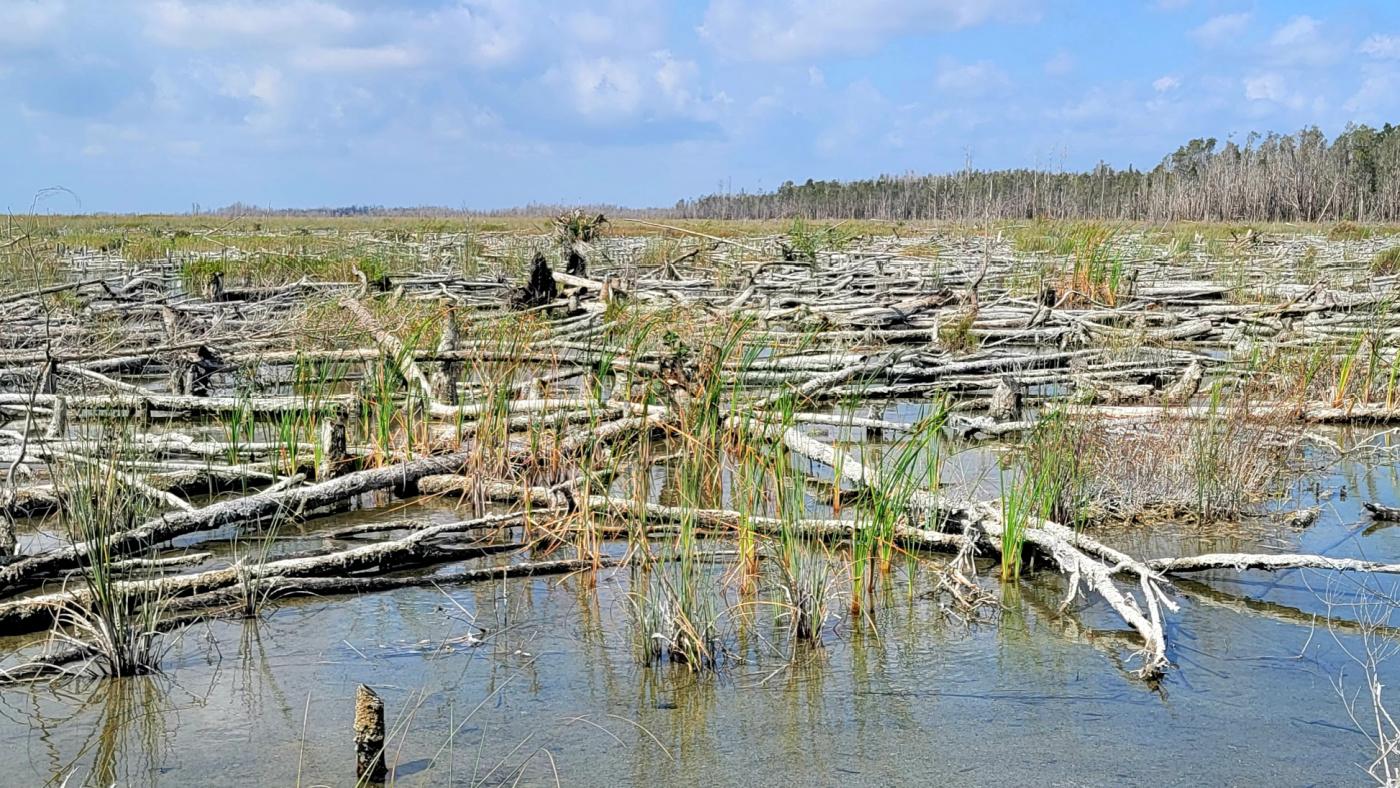
In a landscape once dominated by invasive melaleuca trees, whose husks can still be seen above and below the water, native plants are thriving once again. / Kim O'Connell
Progress Among The Paperbarks
The war against invasive vegetation is long and uncertain, but Everglades National Park is winning one important battle.
By Kim O’Connell
On a humid spring morning in Everglades National Park, Hillary Cooley points to what looks like an ancient book, with brittle pages yellowing under the harsh subtropical sun. Closer inspection reveals that it’s actually a large hunk of a melaleuca tree, also known as the broad-leaved paperbark. Along with river birch, sycamore, and paperbark maple trees, melaleuca bark curls and peels up in layers, like a snake shedding its skin.
Cooley is a botanist who heads up the park’s exotic plants management program. We are in the northeast corner of the national park, a section that was added to the park in the late 1980s, wading through water that reaches our ankles. All around us are melaleuca trees, some of which are flowering. Melaleuca flowers resemble white bottle brushes, giving the trees a feathery, fuzzy appearance when they are in bloom. Some branches carry dozens of seed pods or capsules—the melaleuca’s secret weapon. When those pods open, they release many thousands of seeds, carried away like dust by wind and wildlife. Some estimates say that a single mature melaleuca tree can produce 100 million seeds. “It’s fairly dramatic,” Cooley says.

A cluster of melaleuca seed capsules can contain thousands of seeds. / Kim O'Connell
As visually interesting as it is, however, the melaleuca tree is an invasive species, one of the most problematic plant species in the Everglades. First introduced to Florida from its native Australia in the late 19th century, the melaleuca was long prized as an ornamental species and gained widespread use as a shade tree and soil stabilizer. By the 1930s, officials were spreading melaleuca seeds over the Everglades by airplane, in a misguided attempt to dry up wetlands for more arable farmland. Melaleuca proliferated, eventually covering hundreds of thousands of acres in south Florida, and more than 5,000 acres in the national park alone.
The National Park Service is just one agency among other federal, state, and private partners working to eradicate melaleuca from South Florida. It is one of the top five invasive plant species that plague the Everglades, along with Australian pine, Old World climbing fern, Brazilian pepper, and the seaside mahoe tree. Like many invasive plants, melaleuca trees outcompete native plants for access to air, sun, and water. The trees grow in dense monocultural stands, which disrupt the park’s hydrology, natural fire cycles, light availability, and plant biodiversity.
Cooley moves deeper into the melaleuca forest towards a clearing in the distance. But only when we arrive at the forest’s edge do I grasp the full extent of what we’re seeing—a vast landscape of felled melaleuca trees, their bare trunks long stripped of their paperbark layers, their branches free of leaves. To combat the spread of the species, the park employs an integrated management plan that includes interventions that range from cutting down and treating trees with herbicides to prescribed burns to biocontrols—insects that are natural enemies of the species, including the melaleuca weevil and the melaleuca psyllid. According to a study published in the scientific journal Plant Ecology, in certain cases introduction of the weevil reduced flowering in melaleuca trees by up to 90 percent.
“The last time I was out here,” Cooley says, “I could see evidence of the biocontrols on some of the new growth of the leaves. We like to use an integrated approach of using as many tools as we have available to us, the rotation of the herbicide, chemical treatments, the biocontrols, and then working with our prescribed fire team to burn this area, post-treatment, when we think it's ready.”
In an area of thriving melaleuca trees, Cooley explains, prescribed burns are not usually successful, because fire actually opens mature pods and can release thousands of new seeds. “But once it's treated, [fire] could actually benefit,” she says. “Like if we time the fire, the prescribed fire, right when some of the smaller seedlings are coming up, it can help control those.”
Beyond the forest's edge we walk deeper into the ghostly melaleuca wasteland. All around us, spiky native sawgrass sprouts around the dead trees, working to reclaim this wet prairie and offering evidence that the Park Service and its partners are making headway against this stubborn invasive species.
“This area has been treated several times,” says Cooley. “I can think of two to three times, probably in the last 10 years. ... We are trying to keep this now on a rotation of treating it every three to five years. ... This area, before we had gone through and treated it, was pretty similar in density to what we just walked through.”
I can well believe it. Ringing this wide expanse is a thick forest of trees—nearly all melaleuca—their white trunks gleaming. This is an area still awaiting treatment. “It's a pretty sharp line of trees—the area that's been treated vs. not treated,” Cooley observes.
Federal agencies are now considering the use of another biocontrol, a fly called Lophodiplosis indentata (commonly known as a gall midge), that is a known pest to melaleucas. The flies lay eggs on foliage, and then hatched larvae bore into leaf tissue, encouraging abnormal growths known as galls to form around them. These growths then stunt tree growth, making it easier for other treatments to work.
A federal environmental assessment of the use of Lophodiplosis indentata was released in December 2021, concluding that the midge was recommended and safe to use in the fight against melaleuca invasion. In public comments on the assessment, the North American Invasive Species Management Association (NAISMA) stated its support for the promising additional biocontrol. “Studies on seedlings and saplings indicated that Lophodiplosis indentata caused melaleuca to shift resources to the production of galls and away from flowering and bud growth,” wrote NAISMA Executive Director Belle Bergner. “In combination with L. trifida [an insect already used as a biocontrol], this caused a significant reduction in melaleuca plant growth over six months.”
This new tool in the Park Service’s arsenal, as well as the new native growth in the cleared melaleuca forest, are hopeful signs. “At least for invasive plants,” Cooley says, “there are success stories and things that we should celebrate and feel like we've accomplished and made a difference.”
This article was made possible through the support of Cardo, now Stantec, a global engineering and environmental consulting firm.

A vast open area of treated and felled melaleuca trees, framed by a dense forest of untreated trees in the distance. / Kim O'Connell

Comments
I hope we don't one day regret using these biocontrol insects like we regret the spreading of melaleuca seeds in the 1930s.